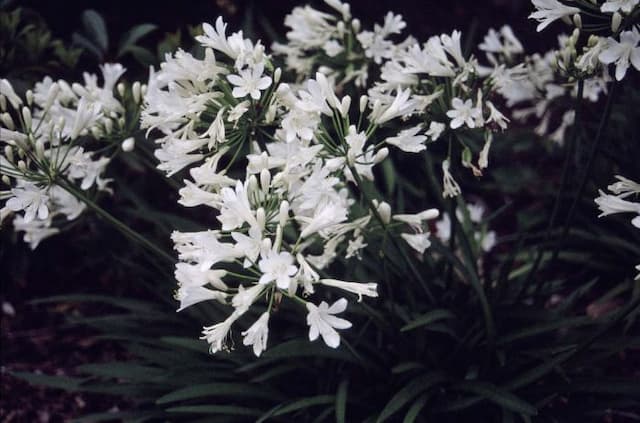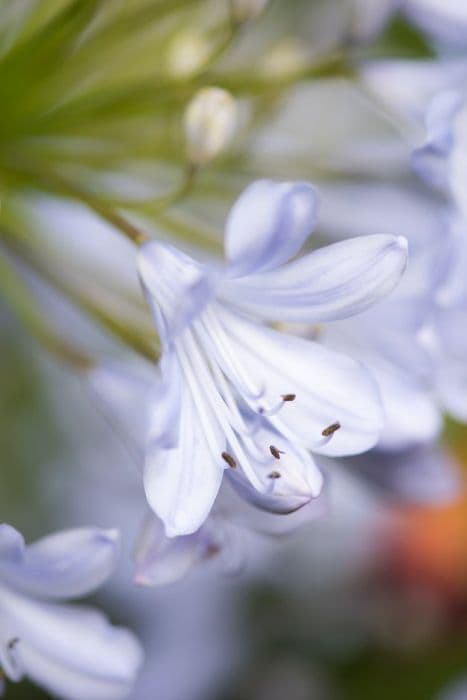African Lily Agapanthus 'Ardernei Hybrid'

ABOUT
The Agapanthus 'Ardernei Hybrid', commonly known as the African Lily, is a striking ornamental plant with a lush, clumping habit. It produces long, slender, arching leaves that are glossy and dark green in color, creating a fountain-like foliage base. The leaves can be quite lengthy and taper to a point, which adds to the visual interest of the plant. The most captivating aspect of the African Lily is its bloom. On top of tall, sturdy stalks, the plant bears large, spherical clusters of flowers. Each cluster is a magnificent display composed of numerous individual trumpet-shaped blooms, which range in shade from deep blue to violet, with some varieties showing hues of white and light blue as well. The blossoms are known for their striking beauty and often attract butterflies and other pollinators. The flowering stalks rise above the foliage, presenting the bloom clusters like fireworks in a verdant sky. The overall appearance of the African Lily is an elegant and bold statement in any garden or landscape, celebrated for both its foliage and its distinct floral displays that contribute to its charm and popularity among garden enthusiasts.
About this plant
 Names
NamesFamily
Amaryllidaceae
Synonyms
African Lily, Lily of the Nile, Love Flower
Common names
Agapanthus 'Ardernei Hybrid'
 Characteristics
CharacteristicsLife cycle
Perennials
Foliage type
Evergreen
Color of leaves
Green
Flower color
Blue
Height
2 feet (60 centimeters)
Spread
2 feet (60 centimeters)
Plant type
Herb
Hardiness zones
Varies
Native area
South Africa
Benefits
 General Benefits
General Benefits- Aesthetic appeal: The showy blue or white flowers of the Lily of the Nile add beauty to any garden or landscape.
- Ease of care: It is relatively low-maintenance, requiring minimal care once established.
- Drought tolerance: It is quite drought-tolerant, making it suitable for xeriscaping and arid environments.
- Attracts pollinators: The flowers can attract bees, butterflies, and other beneficial pollinators to the garden.
- Long blooming period: It has a long flowering season, providing color and interest throughout the summer.
- Deer resistance: Generally resistant to deer, making it a good choice for areas with deer pressure.
- Soil adaptability: It can thrive in a variety of soil types, as long as they are well-draining.
- Coastal garden suitability: It is salt-tolerant and can be grown in coastal areas without ill effects from sea spray.
 Medical Properties
Medical PropertiesThis plant is not used for medical purposes.
 Air-purifying Qualities
Air-purifying QualitiesThis plant is not specifically known for air purifying qualities.
 Other Uses
Other Uses- Agapanthus 'Ardernei Hybrid', commonly known as African Lily, can be used as a natural dye in textiles, providing hues of blue or green depending on the mordant used.
- The mucilaginous leaves of African Lily can serve as a mild pain-reliever when applied topically to small cuts or grazes, similar to how aloe vera is used.
- In some communities, African Lily leaves are used to create a calming tea believed to reduce stress and encourage relaxation, though this is not a scientifically proven use.
- The long, sturdy stems of African Lily can be used in basket weaving or as natural support stakes for other plants in the garden.
- The sap from the stems has been traditionally used in some cultures as a glue for small household repairs or crafts.
- The seeds of African Lily, when dried and treated, can be used as beads or inclusions in jewelry and decorative items.
- Some gardeners use decoctions of African Lily foliage to deter certain pests from other plants, although its effectiveness is folkloric.
- Due to their thick roots, African Lily can be planted in areas prone to soil erosion to help stabilize the ground.
- The flowers can be used to make natural, biodegradable confetti for eco-friendly celebrations.
- Agapanthus leaves can be woven into decorative placemats or coasters for rustic table settings.
Interesting Facts
 Feng Shui
Feng ShuiThe Agapanthus, commonly known as Lily of the Nile, is not traditionally used in Feng Shui practice.
 Zodiac Sign Compitability
Zodiac Sign CompitabilityThe Agapanthus, commonly known as Lily of the Nile, is not used in astrology practice.
 Plant Symbolism
Plant Symbolism- Love Letters: The name Agapanthus comes from the Greek words 'agape' meaning love, and 'anthos' meaning flower, suggesting the plant symbolizes a love letter or a message of love.
- Beauty: With its striking blue to purple flowers, the Agapanthus is often associated with beauty and elegance, making it a representation of natural splendor and visual appeal.
- Fertility: In some cultures, the lush and bountiful blooms of the Agapanthus are considered symbols of fertility and abundance due to their vigorous growth habit.
- Enduring Love: As a perennial that returns year after year, the Agapanthus often symbolizes long-lasting or enduring love.
- Freedom: With its tall flower stalks that seem to reach towards the sky, the Agapanthus can symbolize freedom or liberation, capturing a sense of openness and expansiveness.
- Protection: In some traditions, the Agapanthus is thought to ward off evil spirits, offering protective qualities to those around it.
 Water
WaterAfrican Lily prefers to be watered once a week, allowing the soil to dry slightly between waterings. It's best to use a watering can or hose to evenly soak the soil around the plant. In hotter, drier periods, you may need to water twice a week, ensuring you provide about 1 gallon per watering session for an established plant. During the winter dormant period, reduce watering to every couple of weeks, just enough to prevent the soil from completely drying out.
 Light
LightAfrican Lily thrives in full sun to partial shade. The ideal spot for this plant would have it receive at least 6 hours of direct sunlight daily, though it can tolerate some light afternoon shade. Avoid placing it in deep shade, as this would diminish blooming and potentially weaken the plant.
 Temperature
TemperatureAfrican Lily does well in temperatures between 50°F and 80°F, which are the typical conditions in its growing season. It can survive minimum temperatures down to about 20°F, but it's better to protect it from frosts. The ideal temperature range for this plant would be between 60°F and 70°F for optimal growth and flowering.
 Pruning
PruningAfrican Lily benefits from pruning primarily to remove spent flower stalks and to encourage new growth. Deadheading after flowering can prolong the bloom period and promote a second flush of flowers. Prune in the late winter or early spring by cutting back any damaged or dead foliage to maintain a tidy appearance.
 Cleaning
CleaningAs needed
 Soil
SoilThe African Lily, commonly known as Agapanthus 'Ardernei Hybrid', thrives in fertile, well-draining soil. A mix of loam, compost, and sharp sand or perlite works well, creating a nutrient-rich medium with good drainage. The ideal soil pH for African Lily should be slightly acidic to neutral, ranging from pH 6.0 to 7.0. Amending the soil with organic matter can help achieve the right structure and nutrition for optimal growth.
 Repotting
RepottingAfrican Lilies typically need repotting every three to four years or when they become root-bound. Frequent repotting is not required as Agapanthus 'Ardernei Hybrid' often flowers better when slightly root-bound. It's best to repot in spring before the growing season begins, allowing the plant to establish in its new pot.
 Humidity & Misting
Humidity & MistingAfrican Lily does well in average humidity conditions typical of outdoor environments but does not have specific high humidity requirements. Therefore, maintaining a moderate humidity level similar to the natural outdoor environment should suffice for healthy growth indoors.
 Suitable locations
Suitable locationsIndoor
Place African Lily in bright, indirect light and keep room temperature consistent.
Outdoor
Ensure full sun to partial shade and protect from strong winds for African Lily.
Hardiness zone
8-11 USDA.
 Life cycle
Life cycleThe common name for Agapanthus 'Ardernei Hybrid' is Lily of the Nile. The life cycle begins with seed germination, where under appropriate moisture and temperature conditions, the seeds sprout and develop into seedlings. Next, the seedlings mature into vegetative plants, developing a robust root system and foliage. As the plant progresses, it enters the flowering stage, where buds form and blossom into the characteristic blue or purple flowers. After pollination, which may involve birds, bees, or other insects, the flowers then produce capsule-like fruits that release seeds, completing the reproductive cycle. The perennial nature of Lily of the Nile allows the plant to undergo dormancy during colder months and regrow from its rhizome base each spring, perpetuating its life cycle for many years.
 Propogation
PropogationPropogation time
Spring to early summer
The most popular method of propagation for Agapanthus 'Ardernei Hybrid', commonly known as Lily of the Nile, is through division in late winter or early spring just before new growth begins. To do this, carefully dig up the established clumps and gently separate them into smaller sections, making sure that each new section has at least one or two growing points or shoots. These sections can then be replanted in well-draining soil, preferably in a sunny location, where they can be watered in and allowed to establish. After planting, it's important to keep the soil consistently moist, but not waterlogged, to encourage root growth. Division not only helps propagate new plants but also revitalizes old clumps that might have become less vigorous over time.


![African lily [Blue Storm]](/_next/image?url=https%3A%2F%2Fplants-admin.emdemapps.com%2Fimages%2Fplants%2F%2Fimages%2F604b63200a08b.png&w=640&q=75)






